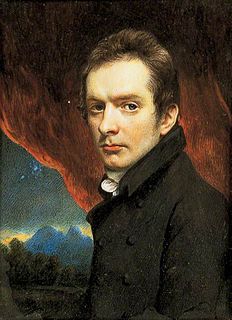
Sir William Robert Grove, FRS FRSE was a Welsh judge and physical scientist. He anticipated the general theory of the conservation of energy, and was a pioneer of fuel cell technology. He invented the Grove voltaic cell.
Edward William Brayley FRS was an English geographer, librarian, and science author.
Edward Wedlake Brayley was an English antiquary and topographer, closely associated with John Britton.

Henry Bone was an English enamel painter who was officially employed in that capacity by three successive monarchs, George III, George IV and William IV. In his early career he worked as a porcelain and jewelry painter. He was elected a Royal Academician and produced the largest enamel paintings ever seen up to that time.

A subscription library is a library that is financed by private funds either from membership fees or endowments. Unlike a public library, access is often restricted to members, but access rights can also be given to non-members, such as students.

John Britton was an English antiquary, topographer, author and editor. He was a prolific populariser of the work of others, rather than an undertaker of original research. He is remembered as co-author of nine volumes in the series The Beauties of England and Wales (1801–1814); and as sole author of the Architectural Antiquities of Great Britain and Cathedral Antiquities of England.
Peter George Patmore was an English author.

The Surrey Institution was an organisation devoted to scientific, literary and musical education and research, based in London. It was founded by private subscription in 1807, taking the Royal Institution, founded in 1799, as a model. The Institution lasted only until 1823, when it was dissolved.

The London Institution was an educational institution founded in London in 1806. It preceded the University of London in making scientific education widely available in the capital to people such as the Dissenters who adhered to non-orthodox religious beliefs and were consequently barred from attending Oxford University or Cambridge University.
The New Monthly Magazine was a British monthly magazine published from 1814 to 1884. It was founded by Henry Colburn and published by him through to 1845.
Sir Benjamin Hawes was a British Whig politician.

William Mudford was a British writer, essayist, translator of literary works and journalist. He also wrote critical and philosophical essays and reviews. His 1829 novel The Five Nights of St. Albans: A Romance of the Sixteenth Century received a good review from John Gibson Lockhart, an achievement which was considered a rare distinction. Mudford also published short fictional stories which were featured in periodicals such as Blackwood's Edinburgh Magazine, Fraser's Magazine, and Bentley's Miscellany. His short story "The Iron Shroud", about an iron torture chamber which shrinks through mechanical action and eventually crushes the victim inside, was first published in August 1830 by Blackwood's Edinburgh Magazine, and later republished separately in 1839 and 1840 with the subtitle "Italian Revenge". Edgar Allan Poe is considered to have been influenced by "The Iron Shroud" when he wrote "The Pit and the Pendulum" having got his idea for the shrinking chamber from Mudford's story. Mudford was born in London, where his father made a living as a shopkeeper in Piccadilly. He was influenced by John Milton, Joseph Addison, Samuel Johnson, William Cowper, William Collins, Mark Akenside, Thomas Gray, and Oliver Goldsmith.

The Blackfriars Rotunda was a building in Southwark, near the end of Blackfriars Bridge across the River Thames in London, that existed from 1787 to 1958 in various forms. It initially housed the collection of the Leverian Museum after it had been disposed of by lottery. For a period it was home to the Surrey Institution. In the early 1830s it notoriously was the centre for the activities of the Rotunda radicals. Its subsequent existence was long but less remarkable.
John Thomas Cooper (1790–1854) was an English chemist notable as a lecturer, chemical supplier and chemical analyst, at a time when interest was burgeoning in chemistry as a discipline of study and application.
Joseph Kemp (1778–1824) was an English musical composer, organist and teacher. He is noted as an early proponent of teaching music in classes and the playing of exercises by students.
The Rotunda radicals were a diverse group of London radical reformers who gathered around the Blackfriars Rotunda after 1830.

John Hazlitt was an English artist who specialised in miniature portrait painting. He was the eldest brother of William Hazlitt – a major essayist of the English Romantic period, as well as an artist and radical social commentator – and had a significant influence on his career.

Prof James Pillans FRSE LLD (1778–1864) was a Scottish classical scholar and educational reformer. He is credited with inventing the blackboard, but more correctly was the inventor of coloured chalk.

John Minter Morgan (1782–1854), was an English author and philanthropist.

William Bengo' Collyer (1782–1854) was an English Congregational minister and religious writer,











